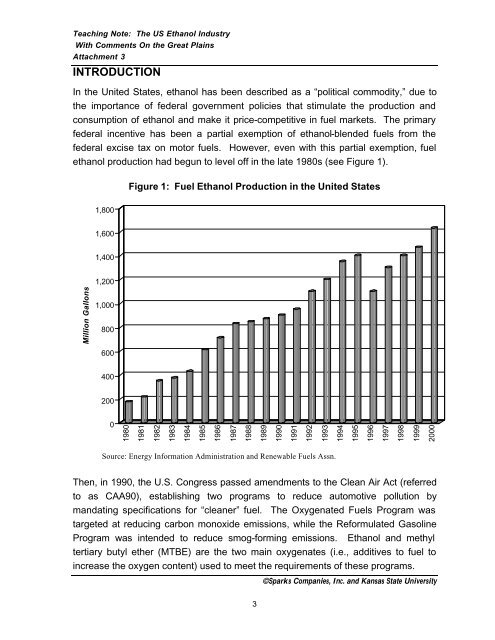teaching note: the us ethanol industry with comments ... - AgManager
teaching note: the us ethanol industry with comments ... - AgManager
teaching note: the us ethanol industry with comments ... - AgManager
Create successful ePaper yourself
Turn your PDF publications into a flip-book with our unique Google optimized e-Paper software.
Teaching Note: The US Ethanol Ind<strong>us</strong>try<br />
With Comments On <strong>the</strong> Great Plains<br />
Attachment 3<br />
INTRODUCTION<br />
In <strong>the</strong> United States, <strong>ethanol</strong> has been described as a “political commodity,” due to<br />
<strong>the</strong> importance of federal government policies that stimulate <strong>the</strong> production and<br />
consumption of <strong>ethanol</strong> and make it price-competitive in fuel markets. The primary<br />
federal incentive has been a partial exemption of <strong>ethanol</strong>-blended fuels from <strong>the</strong><br />
federal excise tax on motor fuels. However, even <strong>with</strong> this partial exemption, fuel<br />
<strong>ethanol</strong> production had begun to level off in <strong>the</strong> late 1980s (see Figure 1).<br />
Figure 1: Fuel Ethanol Production in <strong>the</strong> United States<br />
1,800<br />
1,600<br />
1,400<br />
1,200<br />
Million Gallons<br />
1,000<br />
800<br />
600<br />
400<br />
200<br />
0<br />
1980<br />
1981<br />
1982<br />
1983<br />
1984<br />
1985<br />
1986<br />
1987<br />
1988<br />
1989<br />
1990<br />
1991<br />
1992<br />
1993<br />
1994<br />
1995<br />
1996<br />
1997<br />
1998<br />
1999<br />
2000<br />
Source: Energy Information Administration and Renewable Fuels Assn.<br />
Then, in 1990, <strong>the</strong> U.S. Congress passed amendments to <strong>the</strong> Clean Air Act (referred<br />
to as CAA90), establishing two programs to reduce automotive pollution by<br />
mandating specifications for “cleaner” fuel. The Oxygenated Fuels Program was<br />
targeted at reducing carbon monoxide emissions, while <strong>the</strong> Reformulated Gasoline<br />
Program was intended to reduce smog-forming emissions. Ethanol and methyl<br />
tertiary butyl e<strong>the</strong>r (MTBE) are <strong>the</strong> two main oxygenates (i.e., additives to fuel to<br />
increase <strong>the</strong> oxygen content) <strong>us</strong>ed to meet <strong>the</strong> requirements of <strong>the</strong>se programs.<br />
©Sparks Companies, Inc. and Kansas State University<br />
3






![[U] User's Guide](https://img.yumpu.com/43415728/1/178x260/u-users-guide.jpg?quality=85)









![[P] Programming](https://img.yumpu.com/13808921/1/177x260/p-programming.jpg?quality=85)